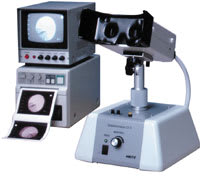Spotlight:
ON TECHNOLOGY AND TECHNIQUE
Low-Cost Cataract Detection
The CT-S Cataract Screener offers advantages over film-based systems.
BY CHRISTOPHER KENT,
SENIOR ASSOCIATE EDITOR
With the Baby Boomers rapidly aging, screening for cataracts will soon become an even more important routine in most practices. Now a cleverly designed tool from Neitz Instruments Co. can make that process faster and more patient-friendly than ever.
Features and benefits
The CT-S Cataract Screener from Neitz Instruments is designed to provide a low-cost way to detect cataracts quickly and easily. Your patient simply looks into the scope -- no darkening of the room or mydriasis is necessary. Infrared light, invisible to the patient, is reflected off the retina, creating a silhouette of any cataractous material in the lens. (A polarizing filter eliminates the light reflected at the cornea.) An image of the lens, showing any cataract, appears on the monitor.
For clarity, the image (both onscreen and in the printout):
- shows which eye is pictured
- provides a scale for gauging the diameter of the iris
- displays an ID number that you assign to the patient.
The CT-S Screener can be connected to a video printer, CRT monitor or VCR, and it allows you to freeze an image so you can adjust the clarity before printing.
Other features include:
- The instrument is lightweight (just over 13 pounds) and compact (less than 13 inches tall).
- The scope rotates 360° so the patient can be seated on any side of the instrument.
- The scope is detachable, so you can examine infants or patients who are lying down.
- The brightness control is stepless/totally adjustable.
Comments from the field
Michael Neider, associate director for photographic services at the Fundus Photography Reading Center, University of Wisconsin, has used the CT-S screener extensively.
|
|
|
|
The CT-S Cataract Screener from Neitz Instruments can be
connected to a monitor, video printer, or other optional peripherals. |
|
"For years we used film to assess cataract progression. Not only is this digital system far more helpful, but the price of the CT-S Screener is about one-third of what we paid for film-based systems.
"The CT-S has several other advantages. We can use a photo slit lamp to retro-illuminate the lens and check cataract progression, but we have to take multiple photos because of the corneal reflection of the white light illumination, which blocks some of the view. In contrast, the screener uses special filters to eliminate the reflection off the surface of the cornea, so we can grade the entire area of illumination with a single image.
"The screener is also very comfortable for patients. It uses infrared light to generate the image, so the patient doesn't perceive any bright light or flash. And it's extremely easy to use.
"Last but not least, the screener is very portable. It's about the size of a shoebox, and you can move it from place to place easily. You can hook it up to a laptop computer, capture an image, burn it on CD or send it via e-mail."
Bringing it on home
The suggested list price of the CT-S Screener is $4,250. For more information, contact S & L Optics at (888) 977-2020, or e-mail Kowa Optimed at ophthalmic@kowa.com.









